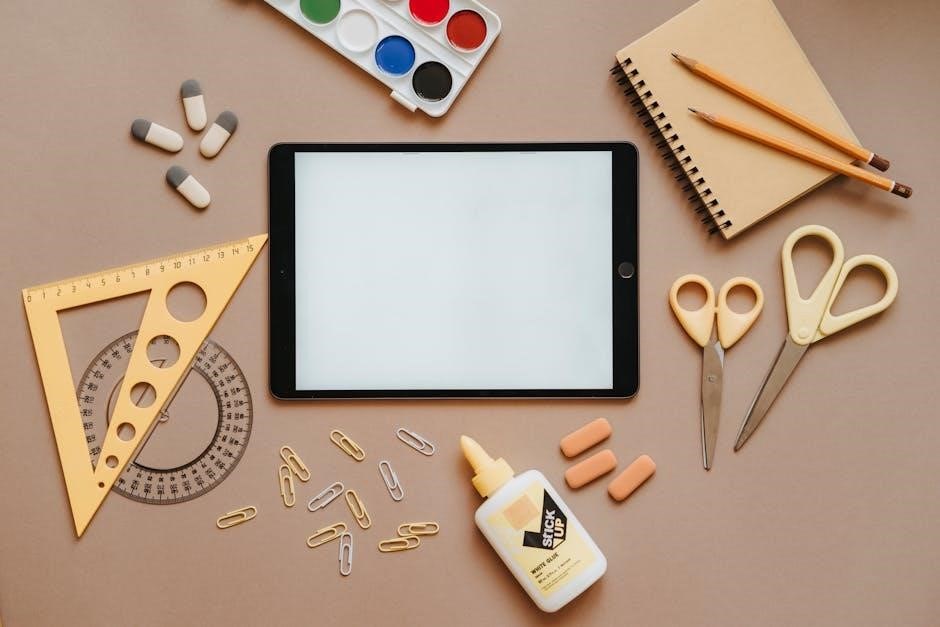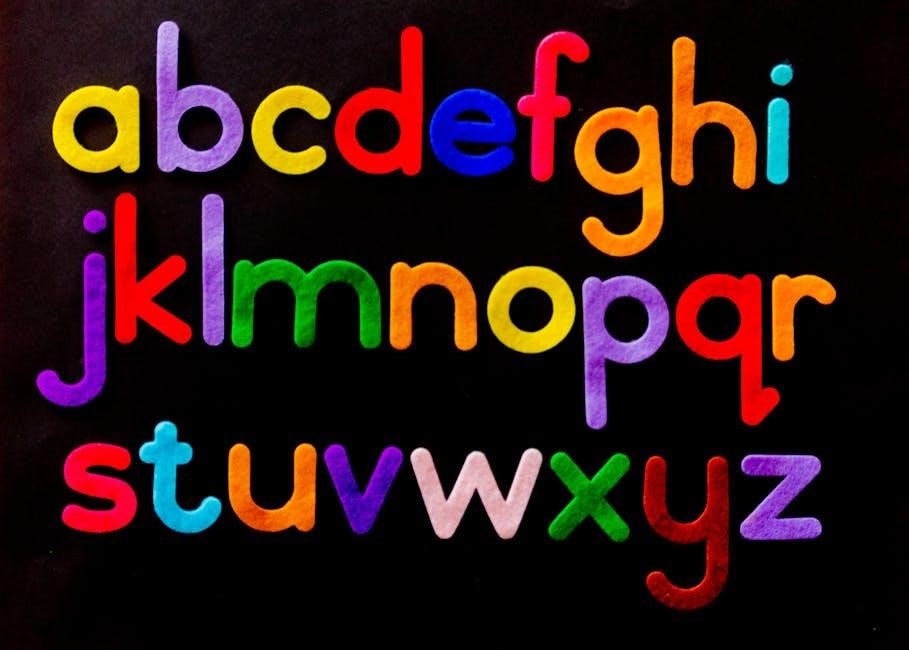
Universal Design for Learning (UDL) is an educational framework that revolutionized teaching by creating flexible learning environments to cater to diverse learning needs and abilities.
Definition and Overview
Universal Design for Learning (UDL) is a framework that aims to create flexible learning environments by providing multiple means of engagement, representation, and expression. It emphasizes accessibility and inclusivity, ensuring that all learners can achieve their full potential. UDL is grounded in neuroscience and recognizes the diversity of learning styles, abilities, and backgrounds. By designing instruction that is adaptable to individual needs, UDL minimizes barriers and maximizes learning opportunities. This approach fosters engagement, understanding, and independence, making it a powerful tool for educators to support diverse learners effectively.
Historical Background and Evolution
Universal Design for Learning (UDL) traces its roots to the 1990s, emerging as a response to the diverse needs of learners in inclusive classrooms. Initially developed to support students with disabilities, UDL has evolved into a comprehensive framework addressing the variability of all learners. Inspired by universal design principles in architecture, UDL applies similar concepts to education, ensuring accessibility and flexibility. Over time, advancements in technology and neuroscience have further refined UDL, emphasizing engagement, representation, and expression. Today, UDL is widely recognized as a cornerstone of inclusive education, supported by research and promoted through initiatives like the National Center on UDL.

Core Principles of UDL
UDL is built on three core principles: engagement, representation, and action & expression, providing flexibility and accessibility to meet diverse learner needs effectively.
Engagement: The Why of Learning
Engagement is the heart of learning, driving motivation and interest. UDL emphasizes creating meaningful connections to students’ lives, leveraging their strengths and interests to foster intrinsic motivation. By offering choices and aligning learning with real-world relevance, educators can captivate students’ attention and sustain their commitment to learning. This principle ensures that learning is not just a passive experience but an active, purposeful journey, where students feel valued and empowered to take ownership of their educational path, making the learning process both enjoyable and impactful.
Representation: The What of Learning
Representation focuses on how information is presented to learners, ensuring accessibility and clarity. UDL emphasizes providing content in multiple formats—such as text, images, and videos—to cater to diverse learning preferences. This principle advocates for flexible ways to perceive and comprehend information, making learning more inclusive. By incorporating technology and multimedia tools, educators can offer options like adjustable fonts, audio descriptions, and interactive simulations. This approach ensures that all learners, regardless of their abilities, can access and understand the material, fostering equity and opportunities for deeper comprehension and connection with the content.
Action and Expression: The How of Learning
Action and Expression focus on how learners demonstrate their knowledge and skills. UDL emphasizes providing multiple means for students to express what they know, such as through writing, speaking, or using digital tools. This principle ensures that learners can choose methods that align with their strengths and preferences. By offering varied ways to act on and express learning, educators can reduce barriers and allow students to apply strategies that work best for them, fostering independence and confidence in their ability to communicate ideas effectively.

Benefits of UDL in Education
Universal Design for Learning enhances engagement, motivation, and overall learning experiences by providing flexible, inclusive strategies that cater to diverse student needs, promoting equity in education;
Inclusivity and Accessibility
Universal Design for Learning (UDL) fosters inclusivity by ensuring all students can access learning materials and activities. It removes unnecessary barriers, allowing diverse learners to engage meaningfully. UDL promotes accessibility by offering multiple ways to present information, such as text, images, and audio, catering to varied learning styles. This approach ensures that students with disabilities, language barriers, or other challenges can participate fully. By designing with accessibility in mind, UDL creates an equitable learning environment where every student can thrive, regardless of their abilities or background.

Improved Academic Performance
Universal Design for Learning (UDL) enhances academic performance by providing flexible learning environments that cater to diverse learning needs. By offering multiple means of engagement, representation, and action-expression, UDL ensures that students can access and understand content in ways that suit them best. This approach minimizes barriers and maximizes each student’s potential to succeed. As a result, learners are more likely to achieve their academic goals, demonstrate deeper understanding, and develop skills that support long-term success. UDL’s focus on inclusivity and accessibility directly contributes to improved learning outcomes for all students.
Enhanced Engagement and Motivation
Universal Design for Learning (UDL) significantly enhances student engagement and motivation by providing flexible and meaningful learning experiences. By offering multiple ways to engage with content, UDL caters to diverse interests and strengths, making learning more relevant and enjoyable. Students are motivated when they can choose how to demonstrate their understanding, fostering a sense of autonomy and ownership. Additionally, UDL’s focus on connecting learning to real-life experiences and prior knowledge increases intrinsic motivation, encouraging students to actively participate and persist in their academic journey.

UDL and Its Role in Supporting Diverse Learners
UDL creates flexible, inclusive learning environments that accommodate diverse needs, ensuring all learners can access and engage with content effectively, fostering equitable education for everyone.
Addressing Individual Learning Differences
UDL emphasizes recognizing and respecting the unique learning needs of each student by offering flexible learning paths and adaptable resources.
This approach minimizes barriers, ensuring learners can access content in ways that suit their individual differences, such as varied learning styles or abilities.
By providing multiple means of engagement, representation, and expression, UDL allows educators to cater to the diverse strengths and challenges of all learners, fostering inclusivity and equity.
Reducing Barriers to Learning
UDL breaks down barriers by offering flexible learning environments and materials that accommodate diverse needs and abilities. It ensures that learners can access content in ways that suit them best.
By minimizing unnecessary obstacles, UDL fosters an inclusive education system where all students can engage meaningfully. This approach supports learners with varying strengths, challenges, and preferences, ensuring equitable access to learning opportunities. Through adaptable tools and strategies, UDL helps create a barrier-free educational experience.

Implementation Strategies for UDL
Implementing UDL involves designing flexible learning environments and integrating technology to provide multiple means of engagement, representation, and expression, ensuring accessibility and inclusivity for all learners.
Designing Flexible Learning Environments
Designing flexible learning environments is a cornerstone of UDL, ensuring that spaces adapt to diverse learner needs. This involves creating adaptable physical setups, such as movable furniture and varied seating options, to accommodate different learning preferences. Additionally, integrating technology like interactive whiteboards and collaboration tools allows for dynamic engagement. Flexible environments also encourage personalized learning paths, enabling students to choose how and where they learn best. By offering choices, educators foster autonomy and inclusivity, making learning accessible and engaging for all students, regardless of their abilities or learning styles.
Integrating Technology and Tools
Integrating technology and tools is essential for implementing UDL effectively. Digital resources like text-to-speech software, interactive simulations, and multimedia presentations provide multiple ways to engage with content. Tools such as collaboration platforms and adaptive learning systems allow students to express their understanding in various ways. Technology also offers real-time feedback, enabling teachers to tailor instruction to individual needs. By leveraging these tools, educators create a dynamic, inclusive learning environment that empowers all students to succeed, regardless of their abilities or learning preferences. This approach aligns with UDL’s goal of providing equitable access to learning opportunities.

Universal Design for Learning (UDL) represents a transformative approach to education, ensuring inclusivity and accessibility for all learners. By addressing diverse learning needs proactively, UDL fosters engagement, reduces barriers, and enhances academic performance. As education evolves, UDL will play a pivotal role in shaping future learning environments, emphasizing flexibility and adaptability. The integration of technology and continuous innovation will further enhance its effectiveness, making UDL a cornerstone of modern educational practices. Its focus on equity and accessibility ensures that every student has the opportunity to thrive, creating a brighter, more inclusive future for education worldwide.